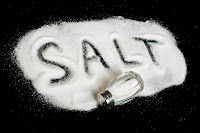The Tale of Three Sous-Vide Ribeyes (42.07mm, 66.8mm & 72.9mm) 1
The methodology of Sous-Vide-Cooking is tied to Time & Temperature. This post will be part of a series that includes many proteins and many variables. The final future post will conclude with a single amalgamated post called "Neo & Morpheus explore Sous-Vide-Cooking and Food Safety."
This reminds me of the proverb, "A little knowledge is a dangerous thing." Before I begin, I wanted to explain what brought me here...I started playing around with this method of cooking in 2006. When I say playing around, I mean this in the loosest terms because I was clueless. I did not really get going until Doughlas Baldwin published "A Practical Guide to Sous-Vide Cooking" His extraordinary work changed Sous-Vide Cooking forever. His work is the go-to guide for everything Sous-Vide, and I am a huge fan.
 I was called out a few years ago for a Time and Temp I suggested. It was a recommendation for a T/T to retherm a steak, and a dogmatic person tried to put me in my place by citing Baldwins's work. I don't mind being corrected, but this person was a TOP--NOTCH-ASS-HAT. After a lengthy dialogue, it was apparent this person had never read Baldwin's work in its entirety. And this person missed the whole point of retherming too. The conversation was cut short. Discourse with a person subscribing to a dogmatic doctrinaire or ideology instead of knowledge is fruitless.
I was called out a few years ago for a Time and Temp I suggested. It was a recommendation for a T/T to retherm a steak, and a dogmatic person tried to put me in my place by citing Baldwins's work. I don't mind being corrected, but this person was a TOP--NOTCH-ASS-HAT. After a lengthy dialogue, it was apparent this person had never read Baldwin's work in its entirety. And this person missed the whole point of retherming too. The conversation was cut short. Discourse with a person subscribing to a dogmatic doctrinaire or ideology instead of knowledge is fruitless.
I'm reminded of another proverb, "A journey of a thousand miles begins with a single step" Other than gaining new knowledge, I still had to prosecute all that I had learned; otherwise, I accomplished nothing, IMO. I had references, footnotes, and a list of books I had read. I lacked real-world data that people could relate to or get behind. I wanted to say, "Been there, done that." I bought a Therma Q Blue with a few Sous-Vide probes. The Therma Q has apps that allow you to record T/T by Secs (CSV Files) and graphs. To say that I love this stuff would be an understatement. Greg Anderson, "Focus on the journey, not the destination. Joy is found not in finishing an activity but doing it".
This post's goal and the forthcoming ones are to create real-world data using real-world meat shapes. Contrary to what you may think, I am not trying to prove or disprove Baldwin's numbers. This also holds true for the Polyscience Sous-Vide Toolbox app (which uses Baldwin's mathematics). Dr. Baldwins says his figures are based on "I've calculated the worst-case cooking times, so you don't have to." The mathematics of Sous-Vide is very complicated...Baldwin "These are non-trivial tasks. Many simplifications and assumptions are necessary". Dr. Baldwin offered his own caveat, which many overlook. The Time to temperature table is "Approximate heating times for thawed meat to 1℉ (0.5℃) less than the water baths temperature. You can decrease the Time by about 13% if you only want to heat within 2℉ (1℃). For thicker cuts and warmer water baths, the heating time may (counter-intuitively) be longer than pasteurization time".
One last caveat before I begin. The Time & Temperatures listed in this post are for personal use, and the conclusions reached are an inference made by me based on specific criteria.
Pasteurization- Do you know how to use the numbers in the table? I am not talking about Baldwin's numbers, which provide the total cooking time to reach core temp and Pasteurization. A pasteurization table will give you a temp and a time. Once the core temp reaches the internal temp listed in the table, it will provide a corresponding time to hold protein for a specific time. I.e., to achieve a 5D reduction at 136f, the meat would first need to reach an internal temp of 130f then be held for 22-Min. A 6.5D Reduction at 130f is 28-Min & 55-Secs. A 7D reduction 136f (FSIS) based on fat% will range from 64-81.f-Minutes (for Poultry). These are just a couple of examples. There are other tables available with different Log Reductions.
There's a caveat..... When cooking at low temps like Sous-Vide and assuming your I.C has been calibrated, the Pasteurization can happen at a different time. Let's not forget that pasteurization and low temp cooking are non-linear. Assuming, of course, you can achieve equilibrium (water & protein at the same temp). Please read Modern Cuisine Vol 1 for more information. Pasteurization will occur if the food takes at least as much Time to reach the core temperature. No other holding time is necessary to achieve Pasteurization at a 6.5D Log Reduction. Examples- 131f/7h,133f/4-H 34-M, 135f/3-H,136f/2-H,138f/1-H 20-M, 140f/5-M/145f/15-M, 147f/11-M (see MC Vol1). Allow me to translate. Let's say your water bath is set at 135.5f (an extra 1/2 degree helps hasten equilibrium), and at the 3-Hour mark, it hits 135f. You just achieved a 6.5D Log Reduction. If it takes longer, that is ok too. Of course, if the cooking time is shorter or you're using a hotter-than-core approach, use a pasteurization table. And, of course, let's not forget we are using probes too.
Let's begin with Baldwin's suggested T/T for slabs. Note: Baldwin's numbers won't align precisely with mine but come awfully close.
The chart will expand when clicked on...
|
Baldwin's Time to Temperature for a 40mm/1.5748" {Mine- 42.07mm/1.6563"} at 134.5℉ takes 2.5 hrs which corresponds to his pasteurization table too. Note: his numbers assume that the meat has an internal temperature of 41℉ (Mine was cooler), and my water bath was a .5℉ cooler, and my slab was 2.07mm thicker. Let's see what the Sous-Vide toolbox offers below.
The sous-vide toolbox allows you to input the numbers, so it's close to comparing apples to apples. What's convenient about the app is the ability to change variables hence changing the T/T. By increasing the water Temp by a .5℉-1℉ (or more), you can cut down on overall Time by a considerable amount. This is called Hotter-Than-Core-Approach.
Tool Box Input
Thickness- 42mm, Final Core Temp- 134℉. Initial Temp (Meat Temp) 38℉, Water Temp- 134℉ {Time to Temperature coincides with Pasteruzaiton, too, which is 3:57:30}.
Tool Box Input
Thickness- 42mm, Final Core Temp- 134℉. Initial Temp (Meat Temp) 38℉, Water Temp- 134.5℉ {Time to Temperature coincides with Pasteruzaiton, too, which is 2:55:39}.
Tool Box Input
Thickness- 42mm, Final Core Temp- 134℉. Initial Temp (Meat Temp) 38℉, Water Temp- 135℉ {Time to Temperature 2:35:34 and Pasteurization occurs at 2:39:15}.
What were my goals? Logging Time and Temps that correlated to specific criteria.
I used 134℉ because this was the best temp for this particular Ribeye. Higher temps are better with fattier meats...Read about this HERE.
🔴🔴🔴🔴🔴🔴🔴🔴🔴🔴🔴🔴🔴🔴🔴🔴🔴🔴🔴🔴🔴🔴🔴🔴🔴🔴🔴🔴🔴🔴🔴🔴🔴🔴🔴🔴🔴🔴🔴🔴🔴🔴🔴🔴
The chart will expand when clicked on...
|
Baldwin's Time to Temperature for a 70/2.75" {Mine- 66.8mm/2.63") at 134.5℉ takes 5.25 hrs, which corresponds to his pasteurization table too. Note: his numbers assume that the meat has an internal temperature of 41℉ (Mine was cooler), and my water bath was a .5℉ cooler, and my slab was 3.2mm thinner.
Tool Box Input
Thickness- 67mm, Final Core Temp- 134℉. Initial Temp (Meat Temp) 37.2℉, Water Temp- 134℉ {Time to Temperature Pasteruzaiton, which is 09:17:31:}.
CRAZY NUMBERS IF YOU ASK ME
Tool Box Input
Thickness- 67mm, Final Core Temp- 134℉. Initial Temp (Meat Temp) 37.2℉, Water Temp- 134.5℉ {Time to Temperature Pasteruzaiton, which is 06:52:37}. A 1/2 ° decreased the Time by 02:24:54. That's huge!!! Why? Getting to equilibrium with thick meats is time-consuming.
Tool Box Input
Thickness- 67mm, Final Core Temp- 134℉. Initial Temp (Meat Temp) 37.2℉, Water Temp- 135℉ {Pasteurization occurs at 6:05:35}. Adjusting temp is makes a huge difference.
🔴🔴🔴🔴🔴🔴🔴🔴🔴🔴🔴🔴🔴🔴🔴🔴🔴🔴🔴🔴🔴🔴🔴🔴🔴🔴🔴🔴🔴🔴🔴🔴🔴🔴🔴🔴🔴🔴🔴🔴🔴🔴🔴🔴
The chart will expand when clicked on...
|
Baldwin's Time to Temperature for a 70mm/2.75" {Mine- 72.9mm/2.87") at 134.5℉ takes 5.25 hrs, which corresponds to his pasteurization table too. Note: his numbers assume that the protein has an internal temperature of 41℉ (Mine was cooler), and my water bath was a .5℉ cooler, and my slab was 3.2mm thinner.
Tool Box Input
Thickness- 73mm, Final Core Temp- 134℉. Initial Temp (Meat Temp) 38.5℉, Water Temp- 134℉ {Time to Temperature Pasteruzaiton, which is 09:16:28:}.
CRAZY NUMBERS IF YOU ASK ME
Tool Box Input
Thickness- 73mm, Final Core Temp- 134℉. Initial Temp (Meat Temp) 38.5℉, Water Temp- 134.5℉ {Time to Temperature Pasteruzaiton, which is 06:51:34}. A 1/2 ° decreased the Time by 02:24:54. That's huge!!! Why? Getting to equilibrium with thick meats is time-consuming.
Tool Box Input
Thickness- 73mm, Final Core Temp- 134℉. Initial Temp (Meat Temp) 38.5℉, Water Temp- 135℉ {Pasteurization occurs at 6:04:33}. Adjusting temp is makes a huge difference.
🔴🔴🔴🔴🔴🔴🔴🔴🔴🔴🔴🔴🔴🔴🔴🔴🔴🔴🔴🔴🔴🔴🔴🔴🔴🔴🔴🔴🔴🔴🔴🔴🔴🔴🔴🔴🔴🔴🔴🔴🔴🔴🔴🔴
Discussion time.......
If you were in a rush, you could increase the temperature by .5℉ or more. SV-Processing a very thick protein would increase the cooking time exponentially, and raising the water temp of the bath just a little would substantially reduce overall cooking time. Reaching equilibrium (Food & Water are equal) can be achieved much faster.
In some cases, you will never achieve an equilibrium state (Food & Water are equal), which can be attributed to several things. Heat transfer is proportional to the temperature difference between the food and the bath (MC Vol1 Chap 5). Heat transfer analysis is very complicated and is tied directly to Thermal Conductivity. Some foods conduct more heat than others and are linked to many things—Contrasting Beef to Chicken, Size, Shape, which muscle water content. I.e., Let's not forget that as the slab gets larger, meaning dimensions, the heat penetration from the sides will be diminished. Let's say you have two proteins that measure..... Protein A- 50mm thick, Width 75mm, and length at 200mm. Protein B- 50mm thick, Width 150mm, and length 200mm. Which one will cook faster? Protein "A" will cook much faster because of the side heat transfer from the sides. There are many other variables, too, like the calibration of the I.C and possible water evaporation (My Joule runs .2f higher, which is better than running lower). Water evaporation and cooling will contribute to erratic temps too.
A better understanding might be for you to visualize a 60mm Fillet and a 60mm Ribeye. Which would cook faster? The Fillet would cook faster. The percentages would not be huge, but the protein with a smaller footprint would cook more quickly. I wrote about Diameter and thermodynamics Here.
Just for clarification, this is GEE WHIZ stuff for all the food nerds out there. I'm not suggesting anyone micromanage every aspect of the cooking process.
























Comments
Post a Comment